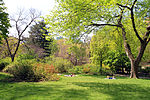The Falconer (Simonds)

The Falconer is a bronze sculpture in Central Park, New York City by English sculptor George Blackall Simonds. It depicts a man in a theatrical version of Elizabethan dress standing on a high granite pedestal, releasing a hunting falcon.The Falconer, cast in 1871 in Florence, was erected in 1875 on a prominent rock overlooking the confluence of Terrace Drive and another carriage drive near the West 72nd Street drive entrance. The growth of surrounding trees has partly obscured the site. The sculpture has a history of being vandalized. The original falcon was stolen, and in the 1960s the New York City Parks Department commissioned their employee and sculptor, Joel Rudnick, to mold a new falcon which now sits on The Falconer's arm. This new falcon is substantially different from the original falcon. The arm itself was also re-fashioned by Parks' employee Domenico Facci.
Excerpt from the Wikipedia article The Falconer (Simonds) (License: CC BY-SA 3.0, Authors, Images).The Falconer (Simonds)
72nd Street Transverse, New York Manhattan
Geographical coordinates (GPS) Address Website External links Nearby Places Show on map
Geographical coordinates (GPS)
| Latitude | Longitude |
|---|---|
| N 40.774111111111 ° | E -73.973805555556 ° |
Address
The Falconer
72nd Street Transverse
10023 New York, Manhattan
New York, United States
Open on Google Maps











